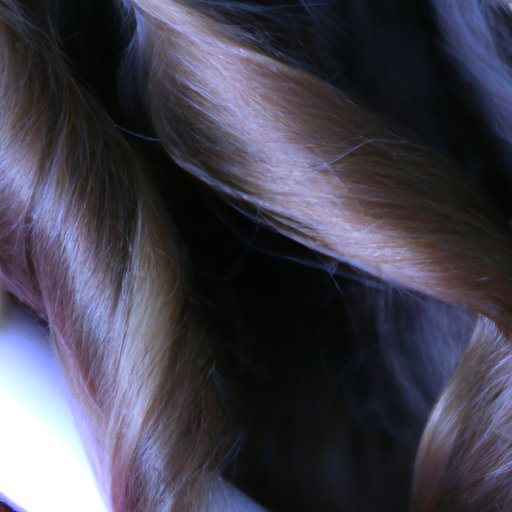
Introduction
Synthetic hair is a popular alternative to human hair for adding length and volume to one’s hairstyle. However, many people struggle with curling synthetic hair as it can be tricky to get the curls to stay in place. This article aims to provide helpful information and tips on curling synthetic hair, including the different types of synthetic hair, techniques for curling, and DIY methods.
Ultimate Guide to Curling Synthetic Hair
Synthetic hair can come in a variety of types, including Kanekalon, Toyokalon, and heat-resistant fibers. It’s important to read the label and follow any care instructions provided, as some types of synthetic hair may not be heat-friendly.
Do’s and don’ts of curling synthetic hair include avoiding direct heat from curling irons or hot rollers, which can melt synthetic hair fibers. Instead, opt for low heat or heat-free methods. Always use a heat protectant spray before applying heat. Lastly, avoid brushing or combing curly synthetic hair too much, as it can cause tangling and frizz.
When it comes to techniques for curling synthetic hair, there are several options. One method is using foam rollers or flexi rods, which can be used without heat. Another is using a low heat curling iron or hot water to set curls. It’s important to work in small sections and use a light touch to prevent damage to synthetic hair.
Recommended products for curling synthetic hair include curling creams and gels specifically designed for synthetic hair. These products can help hold curls in place without causing damage or weighing down the hair.
DIY Synthetic Hair Curls
For those who prefer to curl their synthetic hair at home, there are several simple and practical methods to achieve curls. Using household tools and materials such as straws, socks, or bobby pins can create tight or loose curls. It’s important to work with dry hair and leave curls in place for several hours or overnight to ensure the curls set.
Step-by-step DIY methods for curling synthetic hair include the straw set, which involves wrapping hair around straws and securing with bobby pins, and the sock curls method, which involves wrapping hair around socks and tying the ends together. These methods can create bouncy, natural-looking curls without using heat.
Heat-Free Curls for Synthetic Hair
If heat isn’t your thing, there are natural methods for curling synthetic hair. One popular method is braiding or twisting hair while damp and letting it air-dry. This can create soft waves or tight curls depending on the size and number of braids. Another option is using rollers made from materials such as fabric strips or tissue paper to set curls without heat.
Heat-free curling for synthetic hair comes with several benefits, including preventing damage caused by heat styling tools. It can also help maintain the structure of synthetic hair and prevent tangling or frizz.
Expert Advice: Can You Curl Synthetic Hair?
We reached out to professional hairstylists and experts in the industry to obtain insights on whether it’s possible or advisable to curl synthetic hair. While opinions vary, many stylists agree that it’s possible to curl synthetic hair if done correctly.
Some stylists recommend avoiding heat as much as possible and opting for alternative methods like foam rollers or braiding. Others suggest using low heat and protecting hair with a heat protectant spray. It’s important to consider the type of synthetic hair and follow any care instructions provided.
Curling Synthetic vs. Human Hair
There are several differences between curling synthetic and human hair. While natural human hair can handle high heat and hold curls for longer periods, synthetic hair can be damaged by high heat and may not hold curls as well.
Challenges of curling synthetic hair include the risk of melting or burning hair fibers, frizz, and tangling. On the other hand, human hair can be more expensive and require more maintenance, but can be styled with heat more easily and last longer with proper care.
Benefits of each type of hair include the versatility of styling options for human hair and the affordable price and variety of colors available for synthetic hair.
How to Make Your Synthetic Hair Last
To maintain and care for curly synthetic hair extensions, it’s important to use products that are safe and effective. Gently detangle hair using a wide-tooth comb or brush made for synthetic hair. Avoid using hot water and shampoo hair using a mild or sulfate-free formula. Use a leave-in conditioner to keep hair moisturized and avoid over-styling with heat.
Proper washing and handling can help extend the life of synthetic hair. It’s also important to store hair extensions properly, such as in a satin or silk-lined storage bag or on a wig stand to prevent tangling and damage.
Conclusion
Curling synthetic hair may seem daunting, but with the right know-how and tools, it’s possible to achieve beautiful, long-lasting curls. From low heat methods to DIY solutions, there are plenty of ways to experiment with different styles. Remember to always read labels and follow care instructions for synthetic hair, and be gentle when handling and styling curls to prevent damage. With this ultimate guide to curling synthetic hair, you can confidently rock any style.





